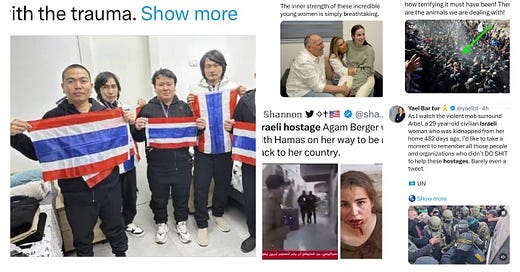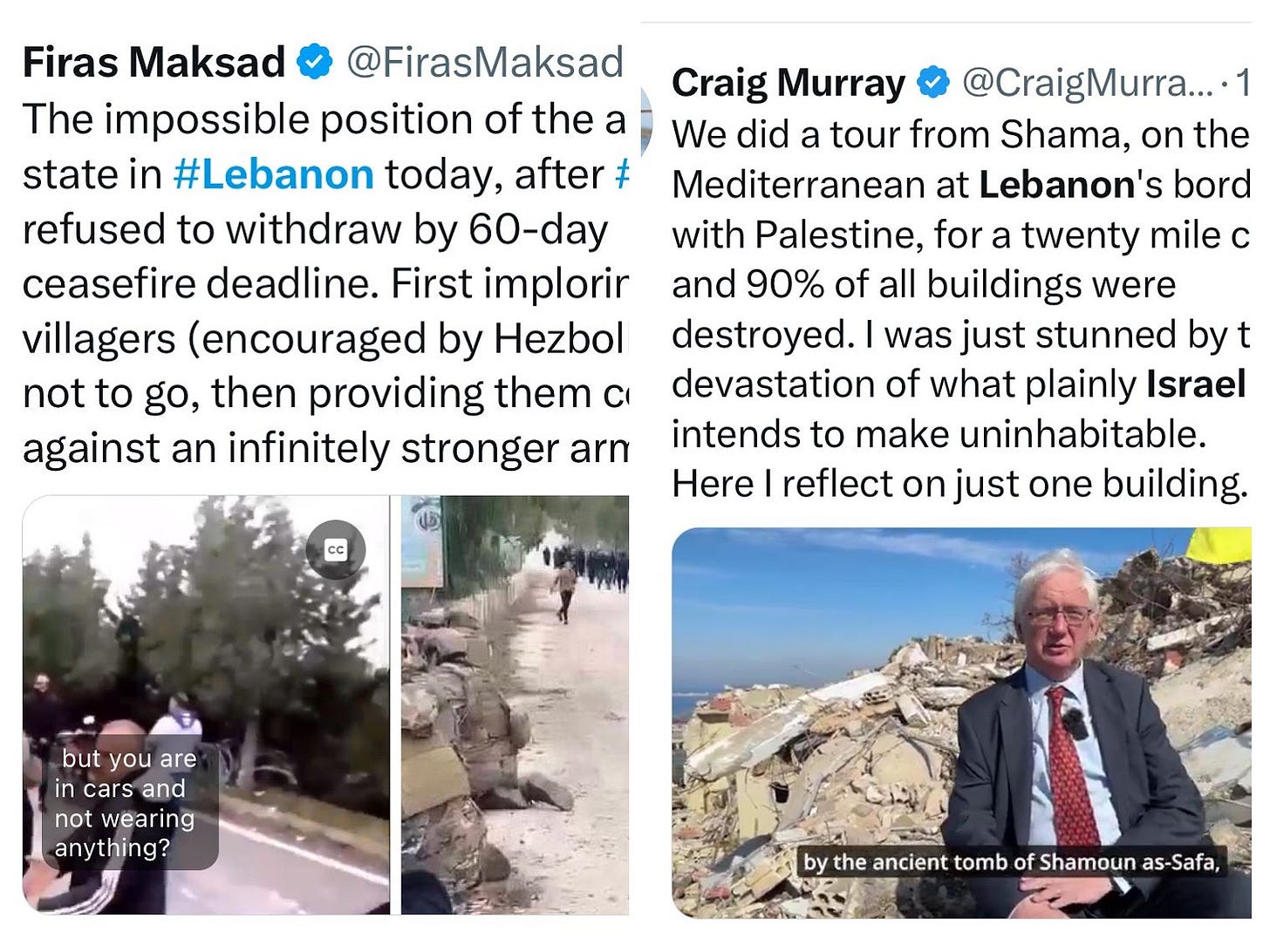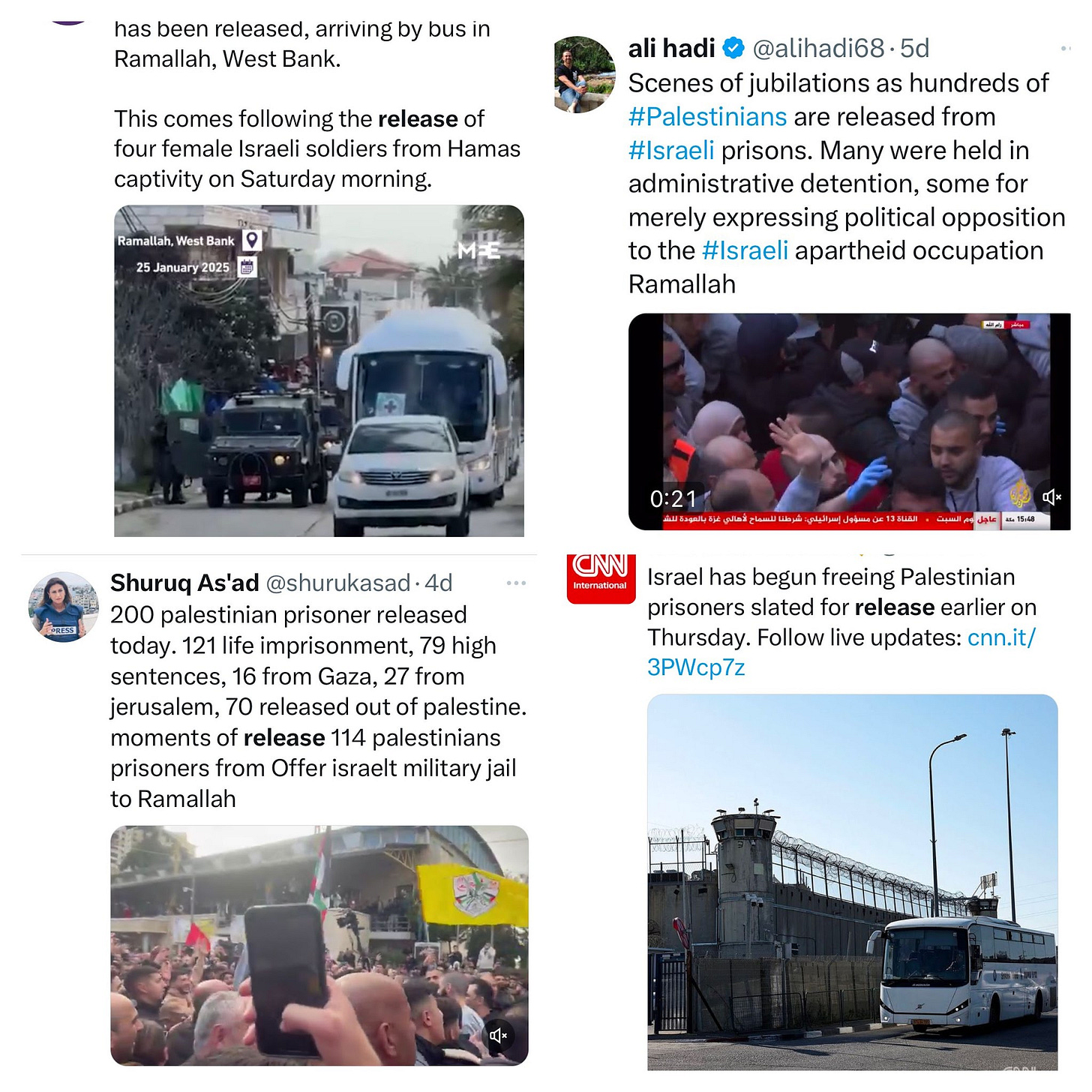Israel at War - Day 483
1. Seven Israeli and Five Thai Hostages Released from Hamas Captivity This Week
This week saw the release of additional hostages in the framework of the ceasefire/hostage deal between Israel and Hamas. On Saturday, four IDF female observers, Naama Levy, Liri Albag, Daniella Gilboa, and Karina Ariev, captured at the IDF Nahal Oz army base on October 7th, 2023, were released and reunited with their families. The female observers were the ones who alerted their commanding officers about the looming Hamas attack, as they detected unusual movements near the border, yet their warnings were ignored.
On Thursday, three Jewish Israeli hostages – Arbel Yahud (29) and Gadi Moses (80) of Kibbutz Nir Oz and Agam Berger (20), an IDF onserver from the Nahal Oz base, were released and reunited with their families. Millions of Israelis were glued to their screens as they watched the tense moments when the released hostages were surrounded by a crowd of Hamas militants and civilians, until they were safely transferred to the hands of the Red Cross.
Five migrant worker Thai citizens who were also kidnapped on October 7th were released, but not as a part of the hostage/prisoners’ exchange deal. They were welcomed by Thai embassy personnel and transfered to a Tel Aviv hospital for further medical care.
All released hostages were transported by an IDF helicopter to a Tel Aviv hospital for initial checkups and medical care. Agam Berger was welcomed at the hospital by the four female observers released a few days earlier.
The “ceremony” that preceded the transfer of the four female observers from the hands of Hamas to the Red Cross on Saturday was covered widely by Israeli, Arab, and international press. The transfer was held at Gaza City's Palestine Square, where Hamas erected a stage underneath which was a poster reading "Palestine - The Victory of the Oppressed People vs the Nazi Zionism". Before boarding the Red Cross vehicles, the released female hostages, wearing military uniforms, were made to stand in front of a crowd of Hamas militants and civilian Gazans. They held hands and smiled, as millions of eyes in Israel were glued to the TV screens. The medical staff at Beilinson Hospital reported briefly that the four young women are "in stable condition, though the prolonged captivity is evident."
Amit Soussana, a hostage released last year in the first ceasefire/hostage deal, reported, in an interview with a Channel 12 investigative journalism show, that Liri Albag, one of the four female observers released on Saturday, saved her life by convincing their captors that Amit was not a soldier, but a civilian. Amit was the first released hostage to publicly share that she was sexually assaulted by the Hamas militant who was assigned to guard her in captivity.
2. PM Netanyahu Will be the First Foreign Leader to Meet President Trump
President Trump invited PM Netanyahu to the White House. Trump said that PM Netanyahu will be the first foreign leader he will meet. The meeting is due next Tuesday in Washington DC. Analysts say that President Trump wants to make sure that Israel fully complies with the hostages deal with Hamas. According to the signed deal, sixteen days into the process the parties should start negotiations on the second phase of the deal, whereby all the rest of the hostages will be released and Israeli forces will fully withdraw from all the Gaza Strip.
PM Netanyahu has a conflict of interest, on the one hand, parts of his coalition, especially the right-wing parties, strongly oppose any halt to the war. They also voted against the hostages deal. They say that releasing hundreds of convicted Palestinian terrorists from Israeli jails will increase the ability of the terrorist organizations to continue to carry out attacks against Israel and many Israelis may die as a result of the releases. They also threaten to leave the current political coalition which may endanger the stability of the government. On the other hand PM Netanyahu would not want to initiate a confrontation with President Trump. President Trump also suggested a plan to evacuate the majority of the population from Gaza and move them, temporarily as he indicated, to Egypt and Jordan, until Gaza is rebuilt. Both countries have already rejected such a plan.
Meanwhile, President Trump's special envoy to the Middle East, Steve Witkoff came to the Middle East to ensure that the deal is being carried out as planned. Witkoff shared that President Trump had tears in his eyes when he saw the hostages coming home. Witkoff started his Middle East tour in Saudi Arabia, to start working on a regional deal that will include Saudi Arabia and Israel. On Thursday he visited Gaza. The First American official to do so in the last fifteen years. He subsequently visited the “Hostages Square” in Tel Aviv, the main site that has become iconic in the last sixtten months since October 7th, where the hostages families hold daily demonstrations with an emphasis on Saturday nights, when thousands of people gather weekly. Witfkoff talked to families of the hostages, and listened to their wish to see their loved ones return home.
3. Ceasefire Between Israel and Lebanon Extended Until February 18th
Israel and Lebanon agreed to extend the ceasefire until February 18th. The ceasefire was in force until Sunday, January 26th. By that time the IDF should have withdrawn its forces from southern Lebanon back into Israeli territory, and the Lebanese army should have taken positions in those locations to ensure Hizbollah forces would not return to the Lebanese villages and towns on the border with Israel. Since Israel discovered that the Lebanese army had not fully implemented the deal and had not fully deployed its forces in all locations, the IDF decided not to withdraw. Israel continues to bomb targets inside Lebanon, which are identified as Hizbollah troops or bases. Meanwhile, Israel has not asked the evacuated Israeli citizens to return to the villages and Kibbutzim that were evacuated in October 2023. More than 50,000 people are still waiting for the government and the army to say that it is safe to re-inhabit the evacuated communities. There is a lot of tension among the evacuees, many of whom are farmers, who have not been able to work their fields on the border with Lebanon.
4. Nomination of the Supreme Court Chief Justice Causes a Constitutional Crisis
Isaac Amit was finally nominated as the permanent chief justice and president of the Supreme Court. This ends another chapter in the ongoing battle between the government, led by the Minister of Justice, Yariv Levin, and the entire legal system, especially the Supreme Court. Levin is the father of the judicial overhaul, who wants to impose what he calls reforms and others define as a coup to destroy the independence of the Supreme Court. Levin tried very hard to change the character of the court, by changing the system to nominate justices. He then refused to convene a meeting of the committee to nominate justices, because he did not want to nominate Amit as president. He considers Amit as too liberal and he wants a conservative justice. After a ruling of the Supreme Court in a petition ordered to convene the committee, and after too many delays, he was forced to convene the committee. But to show his rejection, the minister of Justice, Levin decided not to attend the meeting, although he is the head of the committee. Amit was nominated by the vast majority of the participants. This crisis has been in effect for months. Amit served as the president de facto but as an acting president for a year and a half. Before the nomination, many “sources” leaked indications to the press insinuating that Amit concealed legal violations of the planning and building law. Those allegations were not based on any factual foundations, and they targeted the honesty and integrity of Amit. After the nomination, Minister of Justice Levin announced that he would not cooperate with the new president of the Supreme Court. This is a real constitutional crisis.
5. Four Hundred Palestinian Prisoners Released in Exchange for Hostages
In accordance with the Israel-Hamas ceasefire and hostage agreement, nearly 400 Palestinian prisoners have been released from Israeli detention facilities so far, in exchange for Israeli hostages. Among those released, some were serving life sentences for their involvement in terrorist activities targeting Israeli civilians, while others had not faced any formal charges. The initial phase of the exchange included the release of over 60 women. The youngest prisoner released is 16 years old, and the oldest is 69, who has been incarcerated for more than three decades.
The released prisoners are being returned to various locations; some will be deported to Gaza, while others will be reunited with their families in the West Bank and East Jerusalem. Notable figures among the released include Zakaria Zubeidi, Mahmoud Atallah, and Ahmed Barghouti. Zubeidi, who was convicted for orchestrating multiple terrorist attacks during the Second Intifada and led the al-Aqsa Martyrs’ Brigades in Jenin, was also one of six prisoners who escaped from Gilboa prison in 2021 before being recaptured. Those prisoners who are set to be deported will initially be hosted by Turkey and Qatar before their transfer to Egypt.
While Israeli media largely abstained from publishing images and videos of the Palestinian prisoners' release and the subsequent celebrations in their communities, foreign journalists, including Palestinian reporters, faced challenges in reporting on these events. Israeli and foreign media reported that three Palestinian reporters were summoned for questioning over their coverage of the release of prisoners, and that access was denied to journalists by IDF soldiers. The journalists sought to enter sites where prisoners were released and prisoners’ homes, where receptions were held to celebrate their release.









